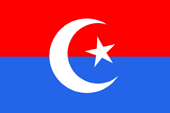Kokand |
|
|
|
| Übersicht – Contents: | |
Kokand |
|
|
|
| Übersicht – Contents: | |
Flaggen – Flags: |
|
 |
18.–19. Jhd./18th to 19th cent., Flagge Khanat Kokand – flag of Chanate of Kokand, Quelle/Source, nach/by: World Statesmen |
 |
1917–1920, Flagge Khanat Kokand – flag of Chanate of Kokand, Seitenverhältnis – ratio = 2:3, Quelle/Source, nach/by: World Statesmen |
Bedeutung/Ursprung der Flagge – Meaning/Origin of the Flag: |
|
| Kokand verwendete eine einfarbige rote Flagge. Rot ist eine Flaggenfarbe mit großer Tradition und großer Verbreitung in der islamischen Welt, von der Türkei über Turkestan zu den Küsten Arabiens, über Sansibar bis zu den Maldiven. Sie steht in engem Zusammenhang zum Islam. Rote Flaggen haben bzw. hatten alle islamischen Dynastien, die sich auf die Herkunft von den Alawiten (auch Aliden genannt, Abkömmlinge Ali's) berufen (z.B. heute noch Marokko, ehemals Nordjemen), oder auch die arabischen Emirate, einschließlich Omans. Außerdem ist Rot die Farbe von Omar, dem zweiten Kalifen. | Kokand
used a single-coloured red flag. Red is a flag color with a great tradition
and wide dissemination in the islamic world, from Turkey over Turkestan to
the coasts of Arabia, over Zansibar to the Maldives, which stands in dense
context to the islam. Red flags had and have all islamic dynasties, which come from the Alawites (Alides, descentants of Ali) like today Morokko or former North Yemen, the Arabian Emirates and Oman. Moreover is red the colour of Omar, the second calif. |
| In der kurzen Phase der Unabhängigkeit als autonomer Staat wurde eine waagerecht gestreifte rot-blaue Flagge mit Halbmond und Stern in der Mitte verwendet, das Symbol des Islam aber auch der Türken. Rot ist die traditionelle Flaggenfarbe des Landes, Blau ist Farbe der Turkvölker und Tataren. | In the short phase of the independence as an autonomous state was in use a horizontal striped red-blue flag with half-moon and star in the middle, the symbol of Islam but even of the Turks. Red is the traditional flag-colour of the country, blue is the colour of the Turk nations and Tatars. |
| Quelle/Source: World Statesmen, Volker Preuß | |
| Turkistan um 1870 – Turkistan about 1870: |
|
| Quelle/Source: Freeware, University of Texas Libraries, modyfied by: Volker Preuß |
Zahlen und Fakten – Numbers and Facts: |
|
|
|
|
|
|
|
|
|
|
|
|
|
|
Geschichte: |
| Antike ·
Besiedlung durch iranische Völker 5. Jhd. n.Chr. · Einwanderung von Turkvölkern 8. Jhd. · arabische Eroberung, Islamisierung 10.–11. Jhd. · Teil des Staats Maverannah (Transoxanien) unter den Samaniden 11. Jhd. · Eroberung durch die Seldschuken 1220 · Eroberung durch die Mongolen unter Dschingis Khan und seinen Nachfolgern 14. Jhd. · Invasionen des Timur 08.04.1369 · Timur wird Emir von Transoxanien mit Residenz in Samarkand 1500 · Eroberung durch die Usbeken, zum Khanat Buchara ca. 1710 · der Usbeke Shah-Rukh gründet das Khanat Kokand, durch Abtrennung des Fergana-Tals vom Khanat Buchara 1758 · Kokand wird von China abhängig (Vasall) 1800–1826 · größte Machtentfaltung von Kokand 1841–1842 · Eroberung durch Buchara, die Truppen Bucharas werden zwar vertrieben, jedoch wird das Land ein Vasall Bucharas 1865 · Eroberung und Annexion von Taschkent durch Russland 1868 · Invasion durch russische Truppen, Kokand wird Vasall Russlands Juli 1875 · Hudayar Khan wird vertrieben, Ende der Dynastie 19.02.1876 · Russland annektiert Kokand, Eingliederung in das Generalgouvernement Turkestan 1917 · Bolschewistischer Putsch in Russland 1917–1920 · Bürgerkrieg 11.12.1917 · autonomer Staat Kokand 1920 · Eroberung durch Truppen Sowjetrusslands, Anschluss an die Turkestanische Autonome Sowjetrepublik 27.10.1924 · Anschluss an Sowjet-Usbekistan 05.12.1929 · Teile des Fergana-Tals werden Sowjet-Tadschikistan angeschlossen |
History: |
| antiquity
· settlement by Iranian nations 5th century A.D. · immigration of Turk nations 8th century · Arabian conquest, islamization 10th–11th century · part of the Maverannah State (Transoxania) under the Samanids 11th century · conquest by the Selchuks 1220 · conquest by the Mongols under Dshingis Khan and his successors 14th century · invasions of Timur 8th of April 1369 · Timur becomes Emir of Transoxania with royal seat in Samarkand 1500 · conquest by the Uzbeks, to the Chanate of Bukhara ca. 1710 · the Uzbek Shah-Rukh establishes the Chanate of Kokand by separation of Fergana Valley from the Chanate of Bukhara 1758 · Kokand becomes a vassal of China 1800–1826 · bigest deployment of power of the Chanate of Kokand 1841–1842 · conquest by Bukhara, the troops of Bukhara become indeed banished, but the country becomes a vassal of Bukhara 1865 · conquest and annexation of Tashkent by Russia 1868 · invasion by Russian troops, Kokand becomes a vassal of Russia July 1875 · Hudayar Khan becomes banished, end of dynasty 19th of February 1876 · Russia annexes Kokand, incorporation into the General Gouvernement of Turkestan 1917 · bolshevist coup d’état in Russia 1917–1920 · civil war 11th of December 1917 · autonomous State of Kokand 1920 · conquest by troops of Soviet Russia, annexation to the Turkestanian Autonomous Soviet Republic 27th of October 1924 · annexation to Soviet Uzbekistan 5th of Dezember 1929 · parts of Fergana Valley become annexed to Soviet Tajikistan |
| Quelle/Source: World Statesmen, Wikipedia (D), Discovery '97 |
Ursprung des Landesnamens – Origin of the Country's Name: |
|
| Der Name "Kokand" geht auf die gleichnamige Stadt zurück. Manchmal wurde das Land auch nach der Landschaft genannt, in der es liegt: "Fergana". | The name "Kokand" is derived from the same-named town. Sometimes the country was called after the landscape in which it is placed: "Fergana". |
| Quelle/Source: Volker Preuß | |